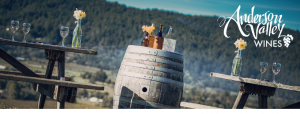Anderson Valley Grape Crush is in the Books; Vintners and Growers Catching their Breath but Pleased
Harvest 2024 concludes after an extended season with overall satisfaction
The future may hold different approaches, Working with Mother Nature and climate change is getting tougher, and we need to start thinking out of the box in our approaches to viticulture.”
PHILO, CA, UNITED STATES, November 4, 2024 /EINPresswire.com/ -- Jeff Jindra, winemaker for Scharffenberger Cellars, catches us up to date on his reflections on Harvest in Anderson Valley, Mendocino County, California, and expects the vintage to result in wines with excellent freshness and a pleasing crunchiness.— Norm Kobler, Winegrower and head of Philo Vineyard Solutions
“Each new growing season is like the next chapter in a never-ending story, beginning the moment the last one concludes,” says Jindra. “The fall weather acts as the prologue, setting the tone for dormancy, like a deep breath before the rush of new growth in the spring. Although vintage 2023 seemed to drag on like a marathon with no finish line, the days after harvest allowed the vines to recharge—like a runner catching their breath—building up energy reserves. With their “batteries” fully charged from stored carbohydrates, the vines stood ready for the demands of vintage 2024.”
As the worldwide wine market experiences a slowdown and even a glut in some regions, Anderson Valley and the popularity of the Valley’s fruit meant that few growers worried, yet 2024 posed an opportunity for winemakers who have been seeking to purchase Anderson Valley fruit.
“In recent years, it has been very difficult for winemakers to purchase fruit from Anderson Valley,” says Norman Kobler, grower and head of Philo Vineyard Solutions. “We get a lot of requests and we’ve had to turn them all away. Now is the time for anyone looking to make wine from some great vineyards to get some initial fruit and establish longer term relationships.”
HARVEST REPORT 2024
Link to the illustrated Harvest Report>>
The winter rains arrived like a gift, soaking the soil to its core and refilling irrigation ponds across the valley. It was a wet season, but not a bone-chilling one, and an early spring acted as a wake-up call, bringing the vines to life in most vineyards by mid-to-late March. Flowering, always a delicate roll of the dice, is nature’s high-stakes gamble. The weather, like an unpredictable dealer in a casino, can make or break it—too hot, too cold, too wet, or too windy and the odds quickly turn against you. Fortunately, flowering this year played out like a winning hand, with mostly favorable conditions allowing for a solid fruit set. With the crop securely in place, the season was cleared for takeoff, like a plane on a smooth runway.
Spring and early summer were warm but not scorching, like a pot slowly simmering without boiling over, creating ideal conditions for both vegetative and berry growth. The vineyard teams, much like marathoners pacing themselves, appreciated the comfortable temperatures. But July arrived like a furnace door swinging open, and the heat dial cranked up mercilessly. Temperatures reached a blistering 115°F on July 6th, and parts of the crop wilted, sunburned under the relentless glare—like leaves left too long under a magnifying glass. While it stung to lose some of the fruit, the rest developed a resilient intensity, with the skins toughening like armor. The extreme heat shortened working hours, and also sped up the ripening process, causing sugars to develop faster than the acids could keep pace.
Historically, these conditions have produced grapes that translate into wines with excellent freshness and a pleasing crunchiness. The extended heat wave led to the first sparkling wine grapes being picked on August 14th, and by the end of the month, still wine producers had joined the fray. Harvest started slowly, but soon gained momentum like a snowball rolling downhill, with each day’s pick accelerating until all the fruit was off the vines in what felt like a whirlwind. Despite the intensity of the season, the vibe in the valley is good with much excitement for the young wines that are showing ripe and bright fruit flavors.
Now, with the vines empty of fruit, preparations for vintage 2025 have already begun. The warm days and cool nights have been like a gentle lullaby, keeping the canopies healthy and allowing the vines to build reserves before they drift off into hibernation.
“The future may hold different approaches,” says Norm Kobler. “Working with Mother Nature and climate change is getting tougher, and we need to start thinking out of the box in our approaches to viticulture.” Anderson Valley is starting the conversation for the future now and will continue discussions at the Pinot Noir Festival Technical Conference led by Christopher Chen, the UCCE Integrated Vineyard Systems Advisor for the North Coast region of California, and scheduled for May 16th, 2025 https://avwines.com/pinot-noir-festival/.
###
About the Anderson Valley Winegrowers Association
The Anderson Valley Winegrowers Association (AVWA) was founded in 1983 – the same year as the appellation. Made up of 25 vineyard, 65 winery and 63 associate members, the nonprofit organization operates with the goal of supporting the region’s premier grape growers and wineries, as well as promoting the region’s distinguished wines. In addition to acting as a resource for its members, the association aims to better its community by donating funds yearly to local nonprofit organizations.
Barbara Barrielle
Anderson Valley Winegrowers Association
+1 707-291-5364
email us here
WATCH NOW: Documentary: Anderson Valley, A Coastal Love Affair with Wine at https://www.youtube.com/watch?v=Fa2a25aA4WI



